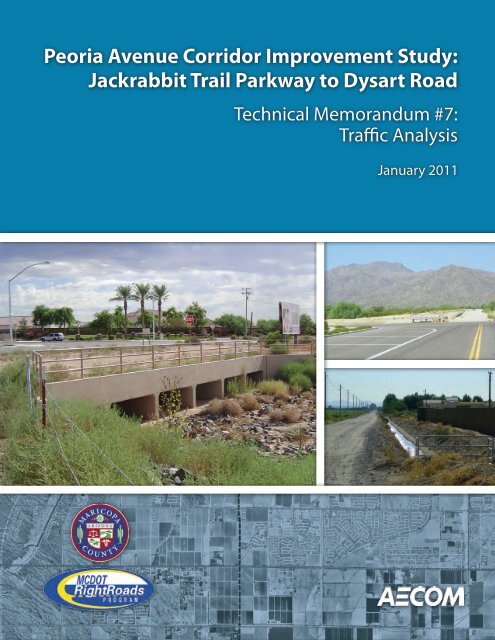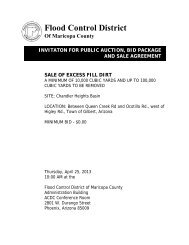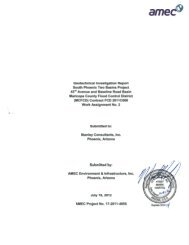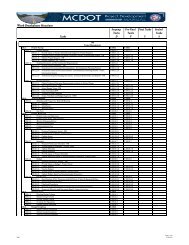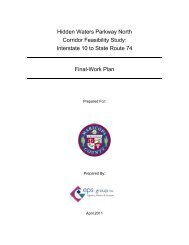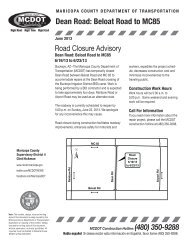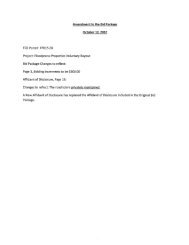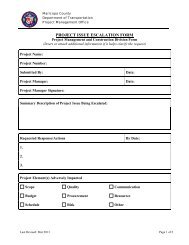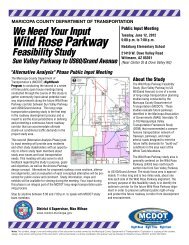Tech Memo #7 - Maricopa County Department of Transportation
Tech Memo #7 - Maricopa County Department of Transportation
Tech Memo #7 - Maricopa County Department of Transportation
You also want an ePaper? Increase the reach of your titles
YUMPU automatically turns print PDFs into web optimized ePapers that Google loves.
<strong>Tech</strong>nical <strong>Memo</strong>randum <strong>#7</strong>Traffic AnalysisPeoria Avenue Corridor Improvement StudyJackrabbit Trail Parkway to Dysart RoadTable <strong>of</strong> Contents1.0 INTRODUCTION ..............................................................................................................12.0 EXISTING TRAFFIC CONDITIONS .................................................................................3Existing <strong>Transportation</strong> Network ..............................................................................................3Existing Traffic Volumes ..........................................................................................................43.0 FUTURE TRAFFIC CONDITIONS ..................................................................................11Future <strong>Transportation</strong> Network ..............................................................................................11Future Typical Sections .........................................................................................................13Future Traffic Volumes ..........................................................................................................144.0 TRAFFIC ANALYSIS ......................................................................................................24Methodology ..........................................................................................................................24Analysis Results ....................................................................................................................26Sensitivity Analysis ................................................................................................................275.0 CRASH ANALYSIS ........................................................................................................34List <strong>of</strong> FiguresFigure 1 – Vicinity Map ................................................................................................................2Figure 2 – Existing <strong>Transportation</strong> Network .................................................................................5Figure 3 – Existing Intersection Configurations ...........................................................................6Figure 4 – Existing ADT Volumes................................................................................................9Figure 5 – Existing 2010 Peak Hour Turning Movement Volumes .............................................10Figure 6 – <strong>Maricopa</strong> <strong>County</strong> Major Streets and Routes Plan Functional Classification ..............15Figure 7 – MAG I-10/Hassayampa Valley <strong>Transportation</strong> Framework StudyFunctional Classification ...........................................................................................16Figure 8 – MAG 2030 Arterial Street System ............................................................................17Figure 9 – City <strong>of</strong> Surprise Functional Classification Map ..........................................................18Figure 10 – City <strong>of</strong> Glendale Functional Classification Map .......................................................19Figure 11 – MCDOT Principal Arterial Cross-Section ................................................................20Figure 12 – MAG Principal Arterial Cross-Section .....................................................................20Figure 13 – City <strong>of</strong> Surprise Major Arterial Cross-Section..........................................................20Figure 14 – City <strong>of</strong> El Mirage Minor Arterial Cross-Section ........................................................21Figure 15 – City <strong>of</strong> Glendale Major Arterial Cross-Section.........................................................21Figure 16 – 2031 Projected Daily Traffic Volumes .....................................................................22Figure 17 – 2031 Projected Peak Hour Turing Volumes ............................................................23Figure 18 – 2031 Lane Configurations and Level <strong>of</strong> Service .....................................................29Figure 19 – Population Density 2005 ........................................................................................30Figure 20 – Population Density 2030 ........................................................................................31Figure 21 – Employment Density 2005......................................................................................32Figure 22 – Employment Density 2030......................................................................................33Page i January 2011
<strong>Tech</strong>nical <strong>Memo</strong>randum <strong>#7</strong>Traffic AnalysisPeoria Avenue Corridor Improvement StudyJackrabbit Trail Parkway to Dysart RoadList <strong>of</strong> TablesTable 1 – Existing Intersection Characteristics ............................................................................3Table 2 – 4-Lane Arterial LOS Thresholds ................................................................................24Table 3 – ADT Volume Warrant ................................................................................................25Table 4 – Control Delays and Corresponding Levels-<strong>of</strong>-Service ...............................................26Table 5 – Socioeconomic Data .................................................................................................27Appendix A – 2031 Intersection AnalysisAppendicesPage ii January 2011
<strong>Tech</strong>nical <strong>Memo</strong>randum <strong>#7</strong>Traffic AnalysisPeoria Avenue Corridor Improvement StudyJackrabbit Trail Parkway to Dysart Road1.0 INTRODUCTIONThe <strong>Maricopa</strong> Association <strong>of</strong> Governments (MAG) prepared the Interstate 10/HassayampaValley <strong>Transportation</strong> Framework Study (Hassayampa Framework Study) that identified acomprehensive roadway network to meet traffic demands for the build out <strong>of</strong> the area west <strong>of</strong>State Route 303 (SR 303L). This long range regional transportation study identified the needfor a roadway network consisting <strong>of</strong> freeways, parkways, and major arterial roads.The Hassayampa Framework Study recommended an extension <strong>of</strong> Peoria Avenue west fromPerryville Road to the future Jackrabbit Trail Parkway, and identified Peoria Avenue as a majorarterial from the future Jackrabbit Trail Parkway to Sarival Avenue. The study area for thisproject includes Peoria Avenue from the future Jackrabbit Trail Parkway alignment to DysartRoad (Peoria Avenue Corridor). The study area generally encompasses a two-mile widecorridor centered on the existing Peoria Avenue. The study area is shown in Figure 1.This study will establish the facility type, number <strong>of</strong> lanes, right-<strong>of</strong>-way needs, and generalalignment for the Peoria Avenue Corridor that will be required to accommodate projected trafficgrowth and enhance safety. In cooperation with the City <strong>of</strong> Surprise, the City <strong>of</strong> Glendale, andthe City <strong>of</strong> El Mirage, the study will also develop access management guidelines, determinedesign standards based upon which jurisdiction anticipates annexing the roadway, and developan implementation plan. In general, the purpose <strong>of</strong> this Corridor Improvement Study is toprovide the <strong>Maricopa</strong> <strong>County</strong> <strong>Department</strong> <strong>of</strong> <strong>Transportation</strong> (MCDOT) and other jurisdictionswith a future “footprint” <strong>of</strong> the Peoria Avenue Corridor and a timeframe for the implementation <strong>of</strong>the recommended future roadway improvements.The key objectives <strong>of</strong> this Corridor Improvement Study are to: Define and assess strategic issues within the project study area; Develop and evaluate conceptual alternative alignments within the corridor study area; Recommend a preferred alignment; Develop consensus for the preferred alignment; Define the characteristics <strong>of</strong> the preferred alignment; and Develop an implementation plan.This technical memorandum identifies the existing and future travel demand, roadway network,and traffic conditions for the Peoria Avenue Corridor.Page 1 January 2011
<strong>Tech</strong>nical <strong>Memo</strong>randum <strong>#7</strong>Traffic AnalysisPeoria Avenue Corridor Improvement StudyJackrabbit Trail Parkway to Dysart RoadFigure 1 – Vicinity MapPage 2 January 2011
<strong>Tech</strong>nical <strong>Memo</strong>randum <strong>#7</strong>Traffic AnalysisPeoria Avenue Corridor Improvement StudyJackrabbit Trail Parkway to Dysart Road2.0 EXISTING TRAFFIC CONDITIONSExisting <strong>Transportation</strong> NetworkFigure 2 illustrates the existing transportation network in the study area. Currently, PeoriaAvenue is a two-lane roadway, with varying degrees <strong>of</strong> improvements. Presently, PeoriaAvenue extends west as far as Perryville Road as a paved road, with the exception <strong>of</strong> one milebetween Citrus Road and Cotton Lane that is unpaved. Between Perryville Road and theBeardsley Canal, an unpaved and narrow maintenance/access road exists. In the wider context<strong>of</strong> the study area, Jackrabbit Trail Parkway does not yet exist; Olive Avenue is the only crossing<strong>of</strong> the Beardsley Canal, granting access to the west; and SR 303L remains a major arterial roadwith no freeway improvements completed. Local roadways are intermittently developed,depending on the degree <strong>of</strong> built residential and industrial land uses. The BNSF Ennis Spurcrosses Peoria Avenue at an at-grade railroad crossing, protected by lights and gates.Based on its current function in the existing network, MCDOT functionally classifies the existingPeoria Avenue roadway as a major collector in the <strong>Maricopa</strong> <strong>County</strong> <strong>Transportation</strong> SystemPlan, February 2007. A major collector provides short-distance (less than three miles) trafficmovement, collects and distributes traffic between local and arterial streets, and provides directaccess to abutting land.The existing portion <strong>of</strong> Peoria Avenue within the study area has eight major cross-streetintersections from Perryville Road to Dysart Road, not including the intersection with SR 303L.The intersection with Litchfield Road is a four-legged signal controlled intersection. The otherseven intersections are either two-way stop controlled or all-way stop controlled. The PerryvilleRoad intersection is a “T” intersection, with the existing Peoria Avenue terminating here. Theroadway lane geometry and intersection traffic control was taken from aerial mapping providedby <strong>Maricopa</strong> <strong>County</strong> and field-verified in August 2010. Table 1 summarizes the configuration <strong>of</strong>these eight intersections, including the type <strong>of</strong> intersection, current traffic control, and number <strong>of</strong>lanes at each approach. Figure 3 shows the lane geometry <strong>of</strong> each intersection along with anaerial plan view <strong>of</strong> the intersection.Table 1 – Existing Intersection CharacteristicsApproach LanesIntersection Type Traffic ControlNB SB EB WBPerryville Road “T”-intersection Three-Way STOP 1 1 n/a* 2Citrus Road Four-legged NB/SB STOP 1 1 2 1Cotton Lane Four-legged EB/WB STOP 1 1 1 1Sarival Road Four-legged Four-Way STOP 3 2 2 2Reems Road Four-legged Four-Way STOP 2 3 1 1Bullard Avenue “T”-intersection Three-Way STOP n/a 2 1 2Litchfield Road Four-legged SIGNAL 2 3 2 3Dysart Road Four-legged Four-Way STOP 3 3 2 3*n/a applies to approach lanes that do not exist (e.g., three-legged intersection).Source: <strong>Maricopa</strong> <strong>County</strong> 2010; Field verification 2010.Page 3 January 2011
<strong>Tech</strong>nical <strong>Memo</strong>randum <strong>#7</strong>Traffic AnalysisPeoria Avenue Corridor Improvement StudyJackrabbit Trail Parkway to Dysart RoadExisting Traffic VolumesHistorical traffic volumes were obtained from the City <strong>of</strong> Surprise and MCDOT for years 2008–2009 where available. In addition, Traffic Research & Analysis, Inc. (TRA) conducted trafficcounts in August 2010, at several locations in the study area. The existing average daily traffic(ADT) volumes within the study area are shown in Figure 4. TRA also conducted turningmovement counts at eight major intersections in the same month. These intersection volumesrepresent existing peak hour traffic between the hours <strong>of</strong> 7:00-9:00 a.m. and 4:00-6:00 p.m.Figure 5 displays the 2010 peak hour turning movements at each <strong>of</strong> the major intersectionsalong the Peoria Avenue study corridor.Existing daily traffic on Peoria Avenue varies in the study area from approximately 900 vehiclesper day (vpd) at the west end to 9,000 vpd between Bullard Avenue and Litchfield Road. Amajority <strong>of</strong> the north/south arterial cross streets along the corridor currently carry more trafficthan Peoria Avenue. With the exception <strong>of</strong> SR 303, Litchfield Road has the highest existingcross street daily traffic volume (16,500 to 14,600 vpd) in the study area.Classification counts were also conducted at three locations within the Peoria Avenue studyarea: (1) Peoria Avenue east <strong>of</strong> Cotton Lane; (2) Cotton Lane north <strong>of</strong> Peoria Avenue; and (3)Litchfield Road north <strong>of</strong> Peoria Avenue. All three locations show that passenger cars comprise avast majority <strong>of</strong> the existing daily traffic volumes (approximately 98%) while large truckscomprise less than 1% <strong>of</strong> the daily traffic volumes. The remaining 1% to 2% is medium-sizedvehicles (buses, RVs, small trucks).Page 4 January 2011
<strong>Tech</strong>nical <strong>Memo</strong>randum <strong>#7</strong>Traffic AnalysisPeoria Avenue Corridor Improvement StudyJackrabbit Trail Parkway to Dysart RoadFigure 2 – Existing <strong>Transportation</strong> NetworkPage 5 January 2011
<strong>Tech</strong>nical <strong>Memo</strong>randum <strong>#7</strong>Traffic AnalysisPeoria Avenue Corridor Improvement StudyJackrabbit Trail Parkway to Dysart RoadFigure 3 – Existing Intersection ConfigurationsPage 6 January 2011
<strong>Tech</strong>nical <strong>Memo</strong>randum <strong>#7</strong>Traffic AnalysisPeoria Avenue Corridor Improvement StudyJackrabbit Trail Parkway to Dysart RoadFigure 3 – ContinuedPage 7 January 2011
<strong>Tech</strong>nical <strong>Memo</strong>randum <strong>#7</strong>Traffic AnalysisPeoria Avenue Corridor Improvement StudyJackrabbit Trail Parkway to Dysart RoadFigure 3 – ContinuedPage 8 January 2011
<strong>Tech</strong>nical <strong>Memo</strong>randum <strong>#7</strong>Traffic AnalysisPeoria Avenue Corridor Improvement StudyJackrabbit Trail Parkway to Dysart RoadFigure 4 – Existing ADT VolumesPage 9 January 2011
<strong>Tech</strong>nical <strong>Memo</strong>randum <strong>#7</strong>Traffic AnalysisPeoria Avenue Corridor Improvement StudyJackrabbit Trail Parkway to Dysart RoadFigure 5 – Existing 2010 Peak Hour Turning Movement VolumesPage 10 January 2011
<strong>Tech</strong>nical <strong>Memo</strong>randum <strong>#7</strong>Traffic AnalysisPeoria Avenue Corridor Improvement StudyJackrabbit Trail Parkway to Dysart Road3.0 FUTURE TRAFFIC CONDITIONSFuture <strong>Transportation</strong> NetworkFor the planned future network, functional classification is the process by which roads aregrouped into classes or systems according to the kind <strong>of</strong> service they will provide in the future.Roadways functionally classified as high-speed, high-capacity facilities tend to maximizemobility and minimize direct land access. The hierarchy <strong>of</strong> functional classification typicallyincludes freeways, expressways, parkways, major and minor arterials, collectors, and localstreets.<strong>Maricopa</strong> <strong>County</strong> and MAG similarly classify Peoria Avenue as an (urban) principal arterial inthe future network. However, Peoria Avenue actually falls within multiple jurisdictions in thestudy area. Each jurisdiction has assigned its own future functional classification to the portion<strong>of</strong> Peoria Avenue within its boundaries. The overlapping classifications are even more complexwhere Peoria Avenue forms the boundary between jurisdictions.For the planned future network, Peoria Avenue has been classified by the local jurisdictions aslisted below: MCDOT – Urban Principal Arterial MAG – Major Arterial City <strong>of</strong> El Mirage – Minor Arterial City <strong>of</strong> Glendale – Major Arterial City <strong>of</strong> Surprise – Major ArterialThe future MCDOT functional classification <strong>of</strong> Peoria Avenue in the study area is an urbanprincipal arterial, as stated in the <strong>Maricopa</strong> <strong>County</strong> Major Streets and Routes Plan, adopted in2001 and revised in 2004 (Figure 6). The corridor currently exists from Dysart to PerryvilleRoads, and is classified as “future” from Perryville Road to Jackrabbit Trail. A principal arterialis defined as a street that provides for long-distance traffic movement within <strong>Maricopa</strong> <strong>County</strong> orbetween <strong>Maricopa</strong> <strong>County</strong> and urban areas. Access to abutting land is restricted and controlledthrough frontage roads and raised medians, as well as by the spacing and location <strong>of</strong> drivewaysand intersections. Opposing traffic flows may be separated by a raised median.MCDOT also classifies all other one-mile grid roadways in the study area as principal arterials,except Perryville Road south <strong>of</strong> Cactus Road, which is defined as a minor arterial and SR 303L,defined as a future freeway.The MAG I-10/Hassayampa Valley <strong>Transportation</strong> Framework Study identifies Peoria Avenueas a major arterial, as illustrated in the functional classification network map in Figure 7. This issupported in the 2010 MAG Regional <strong>Transportation</strong> Plan (RTP), which defines Peoria Avenueas a four-lane arterial from Dysart to Reems Road, and as a six-lane arterial from Reems Roadto Jackrabbit Trail in 2030 (Figure 8).The City <strong>of</strong> Surprise incorporated area within the study area extends north from Peoria Avenue,between the Beardsley Canal and Dysart Road. Surprise classifies Peoria Avenue as a majorarterial in the current General Plan, illustrated in Figure 9.Page 11 January 2011
<strong>Tech</strong>nical <strong>Memo</strong>randum <strong>#7</strong>Traffic AnalysisPeoria Avenue Corridor Improvement StudyJackrabbit Trail Parkway to Dysart RoadIncorporated El Mirage includes the areas both north and south <strong>of</strong> Peoria Avenue east <strong>of</strong> DysartRoad (and therefore out <strong>of</strong> the study area), but also the area south <strong>of</strong> Peoria Avenue betweenthe Ennis Spur and Dysart Road. El Mirage classifies Peoria Avenue as a minor arterial (basedupon City <strong>of</strong> Peoria standard details). El Mirage does not have a functional classification map atthe current time.The City <strong>of</strong> Glendale maintains planning jurisdiction over the south side <strong>of</strong> Peoria Avenue fromthe Ennis Spur to Perryville Road as part <strong>of</strong> its Municipal Planning Area (MPA). One-half milebetween SR 303L and Sarival Road is incorporated, fronting Peoria Avenue to the south.Recent General Plan amendments have upgraded Peoria Avenue to a major arterial roadway(Figure 10).Planned Network ImprovementsMuch <strong>of</strong> the surrounding roadway system to the project area does not exist or is planned to beexpanded or adjusted from its current configuration. SR 303L, Jackrabbit Trail Parkway, andNorthern Avenue Parkway are planned roadway facilities in the surrounding network that areconsidered regional routes.SR 303L CorridorSR 303L is located roughly in the center <strong>of</strong> the study area. It intersects Peoria Avenue betweenCotton Lane and Sarival Road. It has been studied, classified, reclassified, restudied, andultimately confirmed as a major link in the regional and state highway system. SR 303L iscurrently being improved from an interim two-lane roadway into a “Rural Major Freeway,” asclassified by MAG. SR 303L is an important link in the regional freeway system because it willalleviate the bottlenecks on the Grand Avenue arterial (US 60/US 93) and provide a newtransportation corridor for the West Valley.The ultimate improved SR 303L will be a fully access-controlled, grade-separated urbanfreeway with a rolling pr<strong>of</strong>ile that will be elevated or depressed at the arterial crossroads andnear ground level at all other locations. The ultimate freeway will include four general purposelanes with high-occupancy vehicle (HOV) lanes and auxiliary lanes between serviceinterchanges. Thirteen service interchanges for arterial crossroads and two systeminterchanges at Northern Parkway and US 60 are also planned for this freeway.Peoria Avenue is one <strong>of</strong> the thirteen service interchanges planned for the ultimate corridor. Thisinterchange is currently under design as a full diamond interchange. The Stage III ADOTdesign plans have been obtained for this interchange and will be considered throughout thestudy.Jackrabbit Trail ParkwayJackrabbit Trail Parkway has undergone several planning and corridor-level studies in the lastfew years. In the 2007 MAG I-10/Hassayampa Valley <strong>Transportation</strong> Framework Study,Jackrabbit Trail was established as an Arizona Parkway, a new category <strong>of</strong> roadwayclassification in Arizona. The framework study also changed the alignment <strong>of</strong> the corridor –specifically within the Peoria Avenue study area, <strong>of</strong>fsetting it a half mile west <strong>of</strong> the section line– to miss major topographical and drainage features.Page 12 January 2011
<strong>Tech</strong>nical <strong>Memo</strong>randum <strong>#7</strong>Traffic AnalysisPeoria Avenue Corridor Improvement StudyJackrabbit Trail Parkway to Dysart RoadJackrabbit Trail Parkway will follow the new Design Guideline Recommendations for the ArizonaParkway (MCDOT, August 2008), which includes an intermediate-capacity, six- to eight-lanedivided highway with partial access control and no direct left turns permitted at majorintersections. Compared with a conventional arterial, an Arizona Parkway can provideadditional travel capacity without full grade separations at major intersections. It can provide thebenefit <strong>of</strong> increasing intersection capacity while maintaining direct driveway access to eachquadrant <strong>of</strong> the intersection. The junction <strong>of</strong> Peoria Avenue with Jackrabbit Trail Parkway willneed to consider the design standards in the Arizona Parkway Intersection/InterchangeOperational Analysis and Design Concepts Study (MCDOT, August 2009).In 2008, MCDOT completed the Jackrabbit Trail Access Control and Corridor ImprovementStudy, which further refined the corridor and established a preferred alignment, supported bypreliminary engineering considerations that provide operational and design details regarding itsclassification as an Arizona Parkway. Because Peoria Avenue will intersect Jackrabbit TrailParkway, this study can provide guidance for future roadway improvements in the studycorridor.Northern Avenue ParkwayWhile located outside the study area, Northern Avenue through the Phoenix metropolitan areahas been under study for several years, with a view to upgrading it to a “super street.” With afourteen–mile gap in the freeway system between I-10 and SR 101L, Northern Avenue hasbeen envisioned as another east-west connection across the metropolitan area, <strong>of</strong>fering moreaccess control and capacity than a major arterial, but less speed than a freeway.In the MAG I-10/Hassayampa Valley <strong>Transportation</strong> Framework Study, this facility is defined asan Arizona Parkway, positioned approximately one-half mile between the Northern and OliveAvenue section lines throughout the study corridor.Future Typical SectionsAs mentioned previously, Peoria Avenue has been classified by the local jurisdictions asfollows: MCDOT – Urban Principal Arterial MAG – Major Arterial City <strong>of</strong> El Mirage – Minor Arterial City <strong>of</strong> Glendale – Major Arterial City <strong>of</strong> Surprise – Major ArterialA MCDOT principal arterial is six lanes wide, constructed on a minimum right-<strong>of</strong>-way <strong>of</strong> 130 feet,including a bicycle lane. Right-<strong>of</strong>-way for future bus pullouts should be provided on the far side<strong>of</strong> each intersection <strong>of</strong> a principal arterial with another principal or minor arterial – which, in thestudy area, includes every one-mile cross street. Figure 11 illustrates this MCDOT typicalcross-section for Peoria Avenue.A MAG principal arterial is also six lanes wide, constructed on a minimum right-<strong>of</strong>-way <strong>of</strong> 140feet, including a bicycle lane. Figure 12 depicts the MAG typical cross-section for PeoriaAvenue.Page 13 January 2011
<strong>Tech</strong>nical <strong>Memo</strong>randum <strong>#7</strong>Traffic AnalysisPeoria Avenue Corridor Improvement StudyJackrabbit Trail Parkway to Dysart RoadSurprise classifies Peoria Avenue as a major arterial in the current General Plan, whereas ElMirage classifies Peoria Avenue as a minor arterial (based on City <strong>of</strong> Peoria standard details).Typical cross-sections for both cities are illustrated in Figures 13 and 14.The City <strong>of</strong> Glendale has indicated that amendments to the General Plan have upgraded PeoriaAvenue to a major arterial. A typical cross-section for the City <strong>of</strong> Glendale is shown in Figure15.Future Traffic VolumesMAG provided design year 2031 traffic volume projections for use in this study. MAG maintainsa regional traffic forecasting model based on projected socioeconomic data, which providesnumerous outputs including daily traffic and peak hour traffic. MAG network simulations wereprovided for the 2031 design year under the build scenario. For the purposes <strong>of</strong> the MAGmodel, the “build scenario” network corresponds to three traffic lanes in each direction <strong>of</strong> travel.The 2031 Build traffic volume projections are shown in Figure 16.MCDOT does not include a Peoria Avenue crossing <strong>of</strong> the Agua Fria River in its current orfuture roadway network. Other regional planning studies have suggested a need for a rivercrossing and the City <strong>of</strong> El Mirage has included a crossing in its roadway network. While thisriver crossing may not be implemented in the near future, a conservative approach (by includingthe river crossing) was used to project the 2031 Peoria Avenue travel demand. While thetransportation plans described above were used to establish the ultimate Peoria Avenueclassification, the 2031 travel demand will be used to help determine an implementation strategyfor the corridor.The 2031 MAG daily traffic projections were also used to develop projected peak hour turningmovements at the major intersections. The following assumptions were applied to the dailytraffic projections to estimate approach and departure peak hour volumes at each majorintersection: Approximately 8% <strong>of</strong> the daily traffic would occur during the peak hours (K factor) A 60/40 directional split (D factor) would occur during the peak hours with the dominantmovement in the A.M. peak hour being toward SR 303L and to the south with thereverse movement in the P.M. peak hourThe estimated approach and departure volumes were then converted to peak hour turningvolumes utilizing procedures outlined in NCHRP 255. In order to balance the turningmovements, slight adjustments were made to the K factor at isolated locations with the resultingK factors varying between 7% and 9%. The projected 2031 peak hour turning movements areshown in Figure 17.Page 14 January 2011
<strong>Tech</strong>nical <strong>Memo</strong>randum <strong>#7</strong>Traffic AnalysisPeoria Avenue Corridor Improvement StudyJackrabbit Trail Parkway to Dysart RoadSource: <strong>Maricopa</strong> <strong>County</strong> Major Streets and Routes Plan, Street Atlas, revised 2004.Figure 6 – <strong>Maricopa</strong> <strong>County</strong> Major Streets and Routes Plan Functional ClassificationPage 15 January 2011
<strong>Tech</strong>nical <strong>Memo</strong>randum <strong>#7</strong>Traffic AnalysisPeoria Avenue Corridor Improvement StudyJackrabbit Trail Parkway to Dysart RoadSource: MAG I-10 Hassayampa Valley <strong>Transportation</strong> Framework Study, 2007.Figure 7 – MAG I-10/Hassayampa Valley <strong>Transportation</strong>Framework Study Functional ClassificationPage 16 January 2011
<strong>Tech</strong>nical <strong>Memo</strong>randum <strong>#7</strong>Traffic AnalysisPeoria Avenue Corridor Improvement StudyJackrabbit Trail Parkway to Dysart RoadSource: MAG RTP 2010 Update, 2010.Figure 8 – MAG 2030 Arterial Street SystemPage 17 January 2011
<strong>Tech</strong>nical <strong>Memo</strong>randum <strong>#7</strong>Traffic AnalysisPeoria Avenue Corridor Improvement StudyJackrabbit Trail Parkway to Dysart RoadSource: City <strong>of</strong> Surprise General Plan 2030, <strong>Transportation</strong> Plan, 2010.Figure 9 – City <strong>of</strong> Surprise Functional Classification MapPage 18 January 2011
<strong>Tech</strong>nical <strong>Memo</strong>randum <strong>#7</strong>Traffic AnalysisPeoria Avenue Corridor Improvement StudyJackrabbit Trail Parkway to Dysart RoadSource: <strong>Maricopa</strong> <strong>County</strong> Major Streets and Routes Plan, Policy Document, revised 2004.Figure 11 – MCDOT Urban Principal Arterial Cross-SectionSource: City <strong>of</strong> Surprise Street Design Guidelines, 2009.Figure 13 – City <strong>of</strong> Surprise Major Arterial Cross-SectionSource: MAG I-10 Hassayampa Valley <strong>Transportation</strong> Framework Study, 2007.Figure 12 – MAG Principal Arterial Cross-SectionPage 20 January 2011
<strong>Tech</strong>nical <strong>Memo</strong>randum <strong>#7</strong>Traffic AnalysisPeoria Avenue Corridor Improvement StudyJackrabbit Trail Parkway to Dysart RoadSource: City <strong>of</strong> Glendale Standard Detail Index, 2002.Source: City <strong>of</strong> Peoria Standard Detail, 2007.Figure 14 – City <strong>of</strong> El Mirage Minor Arterial Cross-SectionFigure 15 – City <strong>of</strong> Glendale Major Arterial Cross-SectionPage 21 January 2011
<strong>Tech</strong>nical <strong>Memo</strong>randum <strong>#7</strong>Traffic AnalysisPeoria Avenue Corridor Improvement StudyJackrabbit Trail Parkway to Dysart RoadFigure 16 – 2031 Projected Daily Traffic VolumesPage 22 January 2011
<strong>Tech</strong>nical <strong>Memo</strong>randum <strong>#7</strong>Traffic AnalysisPeoria Avenue Corridor Improvement StudyJackrabbit Trail Parkway to Dysart RoadFigure 17 – 2031 Projected Peak Hour Turing VolumesPage 23 January 2011
<strong>Tech</strong>nical <strong>Memo</strong>randum <strong>#7</strong>Traffic AnalysisPeoria Avenue Corridor Improvement StudyJackrabbit Trail Parkway to Dysart Road4.0 TRAFFIC ANALYSISMethodologyArterial Street AnalysisTable 2.1 <strong>of</strong> the MCDOT Roadway Design Manual includes information regarding planning leveltraffic volume thresholds for different facility types. According to this table, a 4-lane urbanarterial can accommodate approximately 35,000 vpd.In addition, planning level analyses were conducted using Highway Capacity S<strong>of</strong>tware toestimate volume thresholds for a 4-lane urban arterial roadway. The following assumptions wereutilized in this analysis: 45 mph free-flow speed 60/40 directional split in peak hour 0.95 peak hour factor (PHF) 9% <strong>of</strong> daily traffic occurs during peak hour Class II street with medians and turn bays 15% turns from exclusive lanes 1 mile segment 3 signals (actuated) Random arrivals (type 3) 90 sec cycle length 0.42 g/c ratioTable 2 shows the resulting daily traffic ranges and corresponding level-<strong>of</strong>-service thresholds.Table 2 – 4-Lane Arterial LOS ThresholdsThis analysis, along with the MCDOT Roadway Design Manual, generally shows that a 4-lanearterial can accommodate approximately 30,000 vpd. Daily traffic volumes greater thanapproximately 30,000 vpd would warrant a 6-lane arterial.Signal Warrant AnalysisADT Range -Level-<strong>of</strong>-ArterialService(veh/day)C < 19,000D 19,000 – 31,000E 31,000 – 33,000F > 33,000Signal warrant analyses were conducted in accordance with MCDOT Traffic EngineeringPolicy/Procedure Guideline (PPG), Section 4, Subject 4.6. This guideline sets forth the ADTvolume warrant to be evaluated for future traffic needs on a new intersection, an intersectionrevised by a proposed roadway construction project, or at the driveway <strong>of</strong> a new commercial orPage 24 January 2011
<strong>Tech</strong>nical <strong>Memo</strong>randum <strong>#7</strong>Traffic AnalysisPeoria Avenue Corridor Improvement StudyJackrabbit Trail Parkway to Dysart Roadresidential development. The warrant is met when the estimated ADT on the major street andon the higher volume minor street or driveway approach to the intersection equals or exceedsthe values in Table 3.Table 3 – ADT Volume WarrantLanes for Moving Traffic on Each ApproachEstimated ADTMajor Street Minor Street Major Street Minor Street1 1 10,000 3,0002 or more 1 12,000 3,0002 or more 2 or more 12,000 4,0001 2 or more 10,000 4,0001 1 15,000 1,5002 or more 1 18,000 1,5002 or more 2 or more 18,000 2,0001 2 or more 15,000 2,000Source: MCDOT Traffic Engineering Policy/Procedure Guideline (PPG), Section 4, Subject 4.6Intersection AnalysisIntersection Level-<strong>of</strong>-Service (LOS) analyses were conducted using Synchro 6.0 in accordancewith procedures outlined in the Highway Capacity Manual (HCM). The concept <strong>of</strong> level-<strong>of</strong>serviceuses qualitative measures that characterize operational conditions within a stream <strong>of</strong>traffic. The descriptions <strong>of</strong> individual levels-<strong>of</strong>-service characterize these conditions in terms <strong>of</strong>such factors as speed and travel time, freedom to maneuver, traffic interruptions, comfort andconvenience. Six levels <strong>of</strong> service are defined for each type <strong>of</strong> facility for which the analyticalprocedures are available. They are given letter designations from ‘A’ to ‘F’, with LOS ‘A’representing the best operational conditions and LOS ‘F’ representing an over-capacitycondition (congestion). Each level-<strong>of</strong>-service represents a range <strong>of</strong> operating conditions.Table 4 below shows the control delays and corresponding levels-<strong>of</strong>-service established in theHCM for signalized intersections.Page 25 January 2011
<strong>Tech</strong>nical <strong>Memo</strong>randum <strong>#7</strong>Traffic AnalysisPeoria Avenue Corridor Improvement StudyJackrabbit Trail Parkway to Dysart RoadTable 4 – Control Delays and Corresponding Levels-<strong>of</strong>-ServiceLevel-<strong>of</strong>-ServiceControl Delay (sec/veh)A < 10B 10 – 20C 20 – 35D 35 – 55E 55 – 80F > 80The following assumptions/input parameters were used in the intersection analysis:Analysis Results Peak hour factor: 0.92 Vehicle travel speed: 45 mph Percentage <strong>of</strong> heavy vehicles: 4% Lane widths: 12 feet Base saturation flow rate: 1,900 pcphpl for all movements Right-turn on red movement was allowed and modeled in the s<strong>of</strong>tware Cycle length: 60 secondsArterial Street Analysis ResultsAs shown in Figure 16, the 2031 traffic volumes along Peoria Avenue range from approximately10,000 vpd to 31,000 vpd. According to the criteria established above, a 4-lane arterial facilitywould be warranted from Jackrabbit Trail Parkway to Dysart Road by 2031.Signal Warrant Analysis ResultsAccording to the criteria shown in Table 3 and the 2031 traffic volume shown in Figure 16, allmajor intersections along Peoria Avenue would warrant signalization by 2031.Intersection Analysis ResultsThe intersection analysis results and recommended 2031 lane configurations are shown inFigure 18. For the 2031 design year, single left-turn lanes are recommended at a majority <strong>of</strong> theintersections with dual left-turn lanes being recommended at Jackrabbit Trail Parkway and atCotton Lane. As signalized intersections, under the conditions shown in Figures 17 and 18, all<strong>of</strong> the intersections are expected to operate at level-<strong>of</strong>-service ‘C’ or better during the peakhours.Page 26 January 2011
<strong>Tech</strong>nical <strong>Memo</strong>randum <strong>#7</strong>Traffic AnalysisPeoria Avenue Corridor Improvement StudyJackrabbit Trail Parkway to Dysart RoadSensitivity AnalysisSince the 2031 traffic volumes warrant a 4-lane facility, a sensitivity analysis was conducted tohelp determine if and when a 6-lane facility might be needed. This analysis included a review <strong>of</strong>2031 socioeconomic data in the MAG model to determine the land use densities assumed in2031; a review <strong>of</strong> the growth trends in the travel demand from 2010 to 2031; and a review <strong>of</strong> theHassayampa Framework Study travel demand model which is generally representative <strong>of</strong> apotential “build-out” scenario in the far west valley.Socioeconomic DataThe thirteen socioeconomic analysis zones (SAZ) within the study area constitute approximately17.5 square miles (less than one-half percent) <strong>of</strong> the 9,223-square-mile MAG planning area andmodeling region. In 2005, the study area had a population <strong>of</strong> approximately 4,550 persons andan employment base <strong>of</strong> approximately 1,500 employees. By 2030, these numbers are expectedto dramatically increase.Table 5 presents the socioeconomic data for the existing 2005 and adopted 2030 forecastscenarios, as well as the percent change between the two forecast years.Table 5 – Socioeconomic DataScenarioPopulation (persons)Employment(employees)2005 4,550 1,5002030 36,330 21,010Percent Change 698% 1,300%Source: MAG, 2010.Population density maps (Figures 19 and 20) show the highest existing density located in thebuilt out/under construction master planned communities located north <strong>of</strong> Peoria Avenuebetween Reems and Litchfield Roads. While that will remain an area <strong>of</strong> higher density, thegreatest densities in the future will be located in the Prasada community, north <strong>of</strong> PeoriaAvenue between Citrus Road and SR 303L. The areas <strong>of</strong> lowest population density includemuch <strong>of</strong> the area affected by the BNSF Ennis Spur and Luke Air Force Base noise contours,and the area surrounding the McMicken Dam. This will remain the same in the future, as thesefeatures are generally incompatible with adjacent residential development.Employment density maps (Figures 21 and 22) illustrate that the largest number <strong>of</strong> existing jobsare located north <strong>of</strong> Peoria Avenue between Reems and Dysart Roads, although theemployment density is still quite low, reflecting an average <strong>of</strong> 1.1 to 4 jobs per acre.Employment growth to 2030 is scattered, with the highest densities <strong>of</strong> jobs located adjacent toSR 303L and Dysart Road. The areas with the lowest employment densities are the McMickenDam and the area south <strong>of</strong> Peoria Avenue between Sarival Road and the Ennis Spur –generally affected by the Luke Air Force Base noise contours.Page 27 January 2011
<strong>Tech</strong>nical <strong>Memo</strong>randum <strong>#7</strong>Traffic AnalysisPeoria Avenue Corridor Improvement StudyJackrabbit Trail Parkway to Dysart RoadA majority <strong>of</strong> the area adjacent to Peoria Avenue has a 2030 population density (less than 4persons per acre) which is lower than the current population density in the more urban areas <strong>of</strong>the valley (6 to 9 persons per acre). Therefore, it is likely that the 2030 socioeconomic dataused in the MAG model is well below the future potential “build-out” <strong>of</strong> the study area. Additionaldevelopment could occur beyond that reflected in the MAG 2030 socioeconomic data that wouldresult in increased travel demand along the Peoria Avenue corridor.Travel Demand Growth TrendsBased on the existing traffic volumes and the 2031 traffic projections, the travel demand alongPeoria Avenue is expected to experience substantial growth over the next 20 years. The annualgrowth rates vary from approximately 5 percent to 100 percent per year. While this type <strong>of</strong>growth in travel demand can occur as development occurs in undeveloped areas, these growthrates cannot be sustained over a long period. Assuming that the annual growth rate beyond2031 will be approximately 15 percent per year, the daily traffic volumes along a majority <strong>of</strong>Peoria Avenue will exceed 35,000 vpd by the year 2040.I-10/Hassayampa Valley <strong>Transportation</strong> Framework StudyAn expanded and updated version <strong>of</strong> the MAG regional transportation model was used t<strong>of</strong>orecast the growth in total travel demand and future changes in travel patterns in theHassayampa Study Area.As the first step in the update <strong>of</strong> the model, MAG developed new build-out population andemployment estimates. “Build-out” refers not to a specific future year, but rather to anunspecified date when urban development will have reached its highest level or maximumextent. These assumptions were based on an amalgamation <strong>of</strong> (1) expected land developmentpatterns and densities in general plans and comprehensive plans, (2) approved privatedevelopment plans, and (3) planned or proposed development plans. Each <strong>of</strong> these sourcesprovided a glimpse <strong>of</strong> the level <strong>of</strong> future development in the MAG planning area and,specifically, the density <strong>of</strong> development for all major land uses. Build-out represents the bestcurrent understanding <strong>of</strong> how the region will develop in the long term. Build-out <strong>of</strong> theHassayampa Valley is expected to occur at least 40 to 60 years in the future.Daily traffic projections were obtained from MAG for the Hassayampa Framework Study model.The daily traffic projections for Peoria Avenue from this model ranged from approximately30,000 to 60,000 vpd which would warrant a 6-lane arterial roadway.Conclusions<strong>Maricopa</strong> <strong>County</strong>, City <strong>of</strong> Surprise, and City <strong>of</strong> Glendale all classify Peoria Avenue as a 6-lanearterial facility. It is likely that the 2030 socioeconomic data used in the MAG model is wellbelow the future potential build-out <strong>of</strong> the study area. Additional development could occurbeyond that reflected in the MAG 2030 socioeconomic data that would result in increased traveldemand along Peoria Avenue. The MAG Hassayampa Framework Study travel demand modelwas based on a build-out scenario <strong>of</strong> western <strong>Maricopa</strong> <strong>County</strong> and produced daily trafficprojections that would warrant a 6-lane arterial facility. Based on the growth trends between2010 and 2031, a 6-lane facility may be warranted by approximately 2040.Page 28 January 2011
<strong>Tech</strong>nical <strong>Memo</strong>randum <strong>#7</strong>Traffic AnalysisPeoria Avenue Corridor Improvement StudyJackrabbit Trail Parkway to Dysart RoadFigure 18 – 2031 Lane Configurations and Level <strong>of</strong> ServicePage 29 January 2011
<strong>Tech</strong>nical <strong>Memo</strong>randum <strong>#7</strong>Traffic AnalysisPeoria Avenue Corridor Improvement StudyJackrabbit Trail Parkway to Dysart RoadFigure 19 – Population Density 2005Page 30 January 2011
<strong>Tech</strong>nical <strong>Memo</strong>randum <strong>#7</strong>Traffic AnalysisPeoria Avenue Corridor Improvement StudyJackrabbit Trail Parkway to Dysart RoadFigure 20 – Population Density 2030Page 31 January 2011
<strong>Tech</strong>nical <strong>Memo</strong>randum <strong>#7</strong>Traffic AnalysisPeoria Avenue Corridor Improvement StudyJackrabbit Trail Parkway to Dysart RoadFigure 21 – Employment Density 2005Page 32 January 2011
<strong>Tech</strong>nical <strong>Memo</strong>randum <strong>#7</strong>Traffic AnalysisPeoria Avenue Corridor Improvement StudyJackrabbit Trail Parkway to Dysart RoadFigure 22 – Employment Density 2030Page 33 January 2011
<strong>Tech</strong>nical <strong>Memo</strong>randum <strong>#7</strong>Traffic AnalysisPeoria Avenue Corridor Improvement StudyJackrabbit Trail Parkway to Dysart Road5.0 CRASH ANALYSISMCDOT provided detailed information on 79 crashes reported along Peoria Avenue between PerryvilleRoad and Dysart Road, during the three-year period beginning January 1, 2004 and ending December31, 2006. A review <strong>of</strong> the crash data showed the following information: Approximately 90% (71 <strong>of</strong> 79) <strong>of</strong> the reported crashes were classified as multi-vehicle crashes. Of these 71 multi-vehicle crashes, approximately 87% were reported as angle (60%) or rear-endcrashes (27%). Of the 79 crashes, approximately 68% were reported as non-injury. One crash involved a fatality. Approximately 82% (65) <strong>of</strong> the 79 crashes were recorded as occurring at an intersection. A review <strong>of</strong> the remaining 14 crashes showed that 1 occurred at a driveway, and 12 crashesoccurred near an intersection (within 200’) even though they were recorded as not related to anintersection or no data was provided as to their relationship to an intersection.Page 34 January 2011
Appendix A


